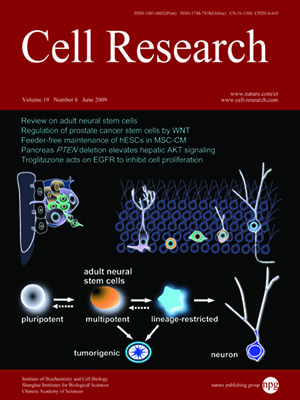
Volume 19, No 6, Jun 2009
ISSN: 1001-0602
EISSN: 1748-7838 2018
impact factor 17.848*
(Clarivate Analytics, 2019)
Volume 19 Issue 6, June 2009: 698-709
ORIGINAL ARTICLES
Feeder-free maintenance of hESCs in mesenchymal stem cell-conditioned media: distinct requirements for TGF-β and IGF-II
Rosa Montes*, Gertrudis Ligero*, Laura Sanchez*, Purificación Catalina, Teresa de la Cueva, Ana Nieto, Gustavo J Melen, Ruth Rubio, Javier García-Castro, Clara Bueno and Pablo Menendez
Andalusian Stem Cell Bank, Instituto de Investigación Biomédica, University of Granada, Granada, Spain
Correspondence: Clara Bueno, Clara Bueno,(clara.bueno.exts@juntadeandalucia.es; pablo.menendez@juntadeandalucia.es)
A paracrine regulation was recently proposed in human embryonic stem cells (hESCs) grown in mouse embryonic fibroblast (MEF)-conditioned media (MEF-CM), where hESCs spontaneously differentiate into autologous fibroblast-like cells to maintain culture homeostasis by producing TGF-β and insulin-like growth factor-II (IGF-II) in response to basic fibroblast growth factor (bFGF). Although the importance of TGF-β family members in the maintenance of pluripotency of hESCs is widely established, very little is known about the role of IGF-II. In order to ease hESC culture conditions and to reduce xenogenic components, we sought (i) to determine whether hESCs can be maintained stable and pluripotent using CM from human foreskin fibroblasts (HFFs) and human mesenchymal stem cells (hMSCs) rather than MEF-CM, and (ii) to analyze whether the cooperation of bFGF with TGF-β and IGF-II to maintain hESCs in MEF-CM may be extrapolated to hESCs maintained in allogeneic mesenchymal stem cell (MSC)-CM and HFF-CM. We found that MSCs and HFFs express all FGF receptors (FGFR1-4) and specifically produce TGF-β in response to bFGF. However, HFFs but not MSCs secrete IGF-II. Despite the absence of IGF-II in MSC-CM, hESC pluripotency and culture homeostasis were successfully maintained in MSC-CM for over 37 passages. Human ESCs derived on MSCs and hESCs maintained in MSC-CM retained hESC morphology, euploidy, expression of surface markers and transcription factors linked to pluripotency and displayed
in vitro and
in vivo multilineage developmental potential, suggesting that IGF-II may be dispensable for hESC pluripotency. In fact, IGF-II blocking had no effect on the homeostasis of hESC cultures maintained either on HFF-CM or on MSC-CM. These data indicate that hESCs are successfully maintained feeder-free with IGF-II-lacking MSC-CM, and that the previously proposed paracrine mechanism by which bFGF cooperates with TGF-β and IGF-II in the maintenance of hESCs in MEF-CM may not be fully extrapolated to hESCs maintained in CM from human MSCs.
Cell Research (2009) 19:698-709. doi: 10.1038/cr.2009.35; published online 24 March 2009
FULL TEXT | PDF
Browse 1995


